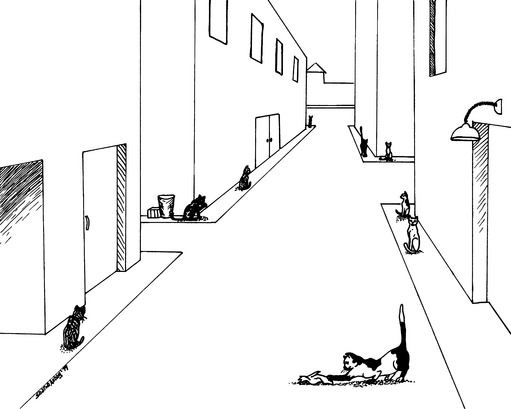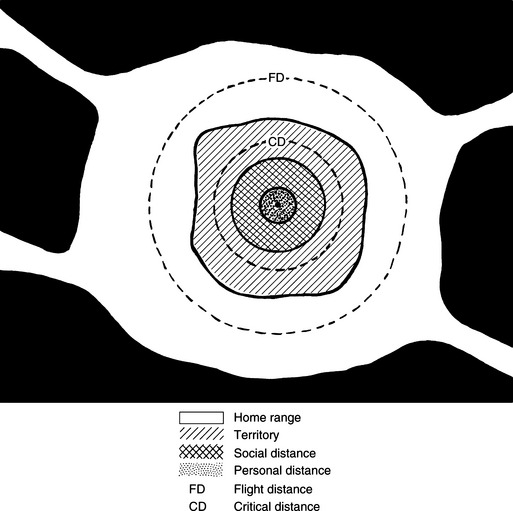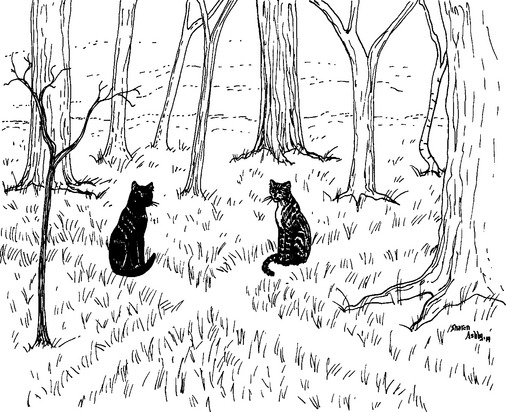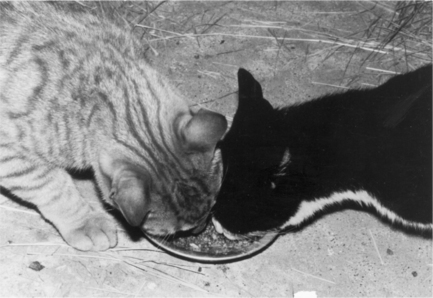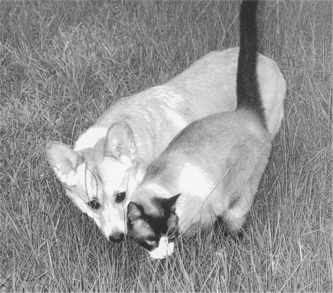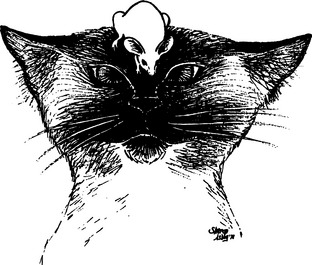Chapter 4 Feline Social Behavior
The social behavior patterns of animals are complex. Nine major social patterns can combine in 45 ways during the interaction of two or more cats.171 Investigative, ingestive, eliminative, and sexual behaviors have some social adaptations but are considered in other appropriate sections.
Social Organization
Domestication involves selective breeding for several generations, but until recently cat breeding has generally been uncontrolled. Cats that received food from humans tended to breed to each other, but with little selective criteria. As a result, today’s cats are organized socially much like their early ancestors, although these social patterns are often interspersed with patterns introduced by selective breeding.182 Social maturity probably does not occur until 2 to 4 years of age,150 so this too must be considered when studying individuals at any location.
Social groups are made up of animals of the same species that are organized in a cooperative manner.37,38,197 There is a relatively stable, long-term membership in the group, and the animals live in family groups or groups larger than the nuclear family.37,38 In contrast, solitary species do not form enduring social relationships and live most of their lives alone.37,38 It is also important to differentiate asocial from antisocial. An asocial species is primarily solitary, coming together for reproduction and when raising young. In contrast, antisocial animals are aggressive toward each other even during reproduction, and young have a very short time of maternal dependency.
Intraspecies Relationships
The ancient Egyptians used a cat symbol to denote a false or deceitful friendship.110 Because cats are not seen in consistently sized groups, their exact social behaviors are difficult to study and are only beginning to be appreciated for their complexity. Speculation often replaces fact. The cat social system is flexible, allowing cats to live alone or in groups of varying size. Cats tend to exist in four very different lifestyles. At one extreme is the feral, independent wildlife, which are totally self-sufficient.108,132 Another lifestyle is the feral, interdependent, free-roaming/unowned cats, which tend to have a colony type of interaction.132 The domesticated, interdependent, free-roaming/loosely owned cats are exemplified by barn cats and those fed by caring strangers.132 Domesticated household cats are almost dependent on their owners.132
Feline social behavior is characterized by an avoidance of interactions,73 or “living apart together.”42 Cats use an active spacing pattern and so are not randomly distributed within a space. Regular, if not actually rigid, schedules of daily activity help maintain spacing between individuals.199 Communication, both by visual contact and by marking behaviors, also helps minimize the amount of close contact between individuals. The cat is able to differentiate conspecifics by urine odors.155 Studies suggest that most cats living without human intervention are solitary.100 Whether any animal tends to be solitary or highly social depends mostly on its primary type of food.104 As a hunter, a cat typically hunts mice, one of which is a single meal for the hunter without any to share. But when cats do live in groups, they are more concentrated near food and shelter.139 Variation in the number of associating individuals is based largely on the local abundance of food and relatedness of individuals.39 Even those living in a group often spend much of their time alone.3,42 Farm cat groups vary from 2 to 11 adult females (mode 4.5), with at least some being related.100 There tends to be an alpha male, but there does not seem to be a typical linear hierarchy, because other parameters typical of such a social order are not present.140
Cats do make social contacts, and the primary one is between a female and her young. Specific epimeletic (caregiving) behavior is covered with maternal behavior, but the social development of the young can be significantly affected by this early experience. Early contact with the queen is obviously significant to the kittens, because when placed in a strange environment, they immediately display ectepimeletic (care-seeking) behavior.163,173 Kittens raised with other kittens tend to become more stressed in loner situations than single-raised kittens.129 Particularly at 2 and 4 weeks of age, contact between littermates is important to calm them in strange surroundings.163,166 Social and play behavior are affected by social contacts with both the mother and the littermates. Deprivation of interaction with littermates results in kittens that do not learn social communication skills, and they have hyperresponses to play objects and in social play.64,125 Kittens who are raised without the mother cat or whose mothers were on low-protein diets during the month either side of parturition have retarded or hypergregarious social behaviors.64,125 Normal social relationships are most readily formed during the first 2 months of age, although there can be a lot of individual variation even within a litter.125
Feline social relationships are often nonenduring: The queen weans her young and the sexual partners do not form bonds. Kittens are social, depending on the interactions of littermates and the queen to develop the skills and knowledge they will later need for a solitary existence. The young males will disperse between 6 and 36 months.39,115,190,200 Males that disperse usually move farther away than do females that leave, and they settle in areas where there is no dominant male.115 Females usually do not go much farther than 650 yards from their birthplace.115 Cats tend to live around other cats, particularly when food is plentiful, and to be solitary hunters. Most of the cats’ time is spent out of each other’s sight, with 35% of the time spent within 10 feet of another cat.5 Even house cats tend to divide the house into individual zones, so the addition or removal of one member can be disruptive as cats redistribute the space.199,200 Males are more likely to be closer than 3 feet.3,5 The rolling behavior often seen may help inhibit overt aggression.52 Female outdoor cats are more likely than males to show affiliative behavior, including social grooming, toward both males and females.5 Cats also are more likely to approach the opposite gender.198 Some cats simply tolerate each other, whereas others can become very devoted and protective toward one or two social partners.
Female cats are more likely to remain in one place their whole life, living alone or in groups of up to eight.115 Usually group members are closely related. When trapped and neutered, the original group remains relatively constant, retaining approximately 75% of the original membership over a 3-year period.202 Group membership does not necessarily mean the cats will spend long periods together, however.100 Although the cats may be near the core area, they are usually alone when in the fields.
The longer these individual cats are together, the stronger their bond becomes, particularly if the relationship started when both cats were young. Littermates that stay together will spend more time in close social behaviors than will happen between unrelated cats.22 Unrelated cats tend to eat one at a time or at well-separated bowls compared with the littermates that often share a food bowl.22 Such a close relationship is characterized by mutual grooming, hunting close to each other (about 50 yards apart), running together (about 6 feet apart), and sleeping together.6,49,59,112,197 The relationships between these cats can be highly structured, with approximately 65% of the interactions involving licking and 28% involving rubbing.100 Feline groups are resistant to the introduction of new cats. New males tend to attack kittens, and new females would initiate a new gene line rather than promote the existing one.37 Because cats have a tendency to be matrilineal, it is best to keep females and their offspring together with only a few males.159 Acceptance of a new cat into a feral colony is a slow process, beginning with life on the periphery.37 Loss of one partner can produce some interesting behavior changes in the other, including anorexia and excessive vocalization.87 In some cases, a previously unassertive cat can show a dramatic personality change that is totally different than the previous one. The time lived together is negatively correlated with the amount of aggression observed.4,5,36,178 Just as close bonds can form,196 it is now known that some cats may actively avoid particular individuals.84,197,198
A very high percentage of cats that live in outdoor colonies are fed by people nearby or have access to food in waste bins. Food is often the common thread that keeps several cats in a specific area. Approximately 45% of the groups have fewer than 10 cat members, as is typical, and 11% have more than 50 members.53,116 Three fourths of the British colonies are older than 5 years and have been altered by human interactions in the past. Barn cats that are mainly self-sufficient almost always live in a population density of less than 100 cats/km2 and usually less than 25 cats/km2.199 Urban densities can reach more than 2000 cats/km2.88,100,199 Social densities of 2.5 to 3.3 cats/km2 or fewer have been reported,96,100,116,192 but such spaces tend to repel cats.88 Distribution data for areas where cats must survive solely on natural prey are not available.
A modification of this semisocial relationship is the neighborhood meeting. In a neutral area in the early evening, local cats of both sexes may gather and sit in a loosely formed circle, usually within 5 yards of each other (Figure 4-1). This quiet social gathering often lasts several hours before the participants depart for their own home areas.6,41,50,59
Cat-Human Relationships
Cats have had a variety of relationships with people over the centuries. Even today the tendency is to love them or hate them. They have a number of traits that make them desirable pets.78 Their small size is the first. That they will eliminate in a litterbox rather than requiring special trips outdoors is particularly nice for high-rise apartment living. In addition, they adapt well to being the only pet and to staying alone for long periods. As the human demographics began changing to more urban living, the popularity of cats soared.
The role of nature versus nurture has been questioned regarding the relationship of cats to humans. Genetics, particularly the sire’s contribution, has been reported to be more significant in the amount of a cat’s friendliness toward humans than how it was handled or socialized as a kitten.162,184 However, friendlier mothers do not tend to have friendlier kittens.184 This genetics research has since been reinterpreted to suggest that the parameter being evaluated as friendliness was actually boldness.127 Cats socialized to people and those from friendly sires are not only friendlier to unfamiliar people, but they also show fewer signs of distress when approached and handled by strangers.127 Socialization to humans is different from and independent of socialization to other cats.130 For those cats that do interact with people, their behavior toward people tends to be relatively constant after socialization.184 Kittens that are not socialized to people take longer to approach and have fewer interactions.98 When they are socialized to people but encounter unfamiliar people, cats will show more direct contacts with them than with familiar people, with most of the attention behaviors shown to people of both groups on the first day.158 Availability, sex, and age of the person with whom the cat interacts affect the relationship.130 In general, the strongest relationships tend to occur with women and the weakest occur with juveniles,130 although this might be related to the human’s activity and vocal patterns.131
The cat-human relationship may be more like an ectepimeletic, kitten-mother relationship than an adult conspecific one. Behaviors such as rubbing against a person’s leg, lying down to be petted, and kneading while being held, all behaviors for which cats have been selectively bred, illustrate this infant-mother relationship.70,74 Vertical tail approaches to humans suggest a kitten approaching its queen rather than its littermates. Conversely, a cat licking a human is mimicking mutual grooming of contemporaries.
While the cat population was increasing because of the cat’s desirability as a pet, those who did not like cats continued to express their views. Approximately 10 million cats are surrendered to shelters each year, with around 70% of those having to be euthanized.88 Some of these cats have to be trapped to get them, and they are poor candidates for pets because most can be tamed only after a great deal of time and patience.132 Few people are willing to put in that amount of effort. The feral cat programs may have another impact that is not well recognized. Those cats that are not trapped and thus not neutered may increase the genetic selection for wildness.23
The cat’s reactions to environmental happenings reflect its lack of strong social bonds. When trapped in a dangerous situation, such as a house fire, the cat’s instinct for self-preservation dictates escape. Only if escape is blocked will the cat recruit assistance from a human and coincidentally save the human’s life. Cats are most often honored with hero awards when using this behavior in a burning building. Occasionally cats have been reported to serve as seeing-eye cats or hearing-ear cats, to fight off snakes endangering a child, and to call attention to a trapped cat or person.156,164
Social Distances
Several distances and areas have social significance to the cat. The area traveled during normal activities is called the home range, and although it is generally considered circular, the shape is actually quite variable (Figure 4-2). A home range will have enough food to sustain the individual and perhaps others, and it is not uniformly used by the individual.93 The size of area is highly correlated to metabolic needs and amount of meat needed in the diet.62 The central, or core, area, where a cat spends 80% of its time, is approximately 0.5 acre, or 20,000 m2.154 In addition to the core, the cats may use the range evenly or have radiating paths leading to secondary home sites for special purposes, such as hunting, elimination, or resting.* As size of the home range increases, the percentage of the area visited daily drops from 38% to as low as 5% without apparent consequences.186 Paths to commonly used locations are chosen for length and direction.160 Both the paths and the special areas may be part of the home range of several individuals.72,165,186 Usage of the paths is not based on dominance but on a passive first-come, first-served basis. Scheduling can be very important in a cat’s routine, with feeding times or travel schedules determining when a cat is in a certain location. Cats arriving at an intersection at the same time will sometimes sit for long periods, each waiting for the other to take the initiative59,113 (Figure 4-3).
The size of a home range varies considerably, depending on food availability and sex of the cat. The size for males averages 3.5 times larger than for females in the same general area,117 and cats are reported to travel 230 to 2770 feet daily.154,185 The size of the home range varies from 0.2 acre for females and 2.1 acres for males where cats are well fed, up to 667 acres for females and 1038 acres for males in the Australian bush.* The mean for free-roaming females is 42 acres, and that for males is 153 acres.100 The home ranges of solitary cats overlap more than expected by chance.100 Home ranges of females do not overlap between groups but are shared by females of that specific group, sometimes with their male.40,115 Female cats from the same farm have a 55.1% overlap of each other’s home ranges compared with a 3.5% overlap with nonresident female cats.39 Males from the same farm have a 56.5% overlap with each other and a 14.4% overlap with the home range of males from other locations.39 Specifics are more inconsistent in free-ranging male cats because their home ranges may not have a specific outer boundary.112 Inside a house the average cat uses 40 square yards of living space.80 Adult males use more rooms in the home (average 5.4) than adult females (average 3.9) as part of their home range.12,13 Most cats have favorite spots where they can be predictably found, with different spots used at different times of the day.13 Generally there will be individuals moving to empty or recently vacated spots rather than groups lying together.13
Juveniles tend to appropriate parts of their dam’s home range in the spring, and if they do not stay in the group, they will use a distinct range in the summer.200 When juvenile males emigrate, they may establish their home range next to that of their sire.200 If a tom is removed, immigration of another tom will occur within a few days; however, immigration of females into an established area is uncommon.200
A territory is an area that is actively defended against strangers of the same species (see Figure 4-2), and such an aggressive encounter should be won almost exclusively by the territory’s owner.39 Generally a territory is smaller than a home range, but in the case of the house cat, territory and home range may be identical. The difficulty in obtaining more precise information about social distances is related to the cat’s solitary nature, its agility, and its nocturnal patterns. In roaming cats, the minimal territorial size is estimated to be 0.1 square mile.6,113,181 Males are more territorial and form larger, more rigid, and more permanent territories.181,193 These areas are small enough to be observed by the resident male cat in toto and are regularly patrolled and marked by him.113 Although tomcats may eat at a common source and sleep in close proximity, their territories seldom overlap, they avoid each other on common pathways, and their territories are not contiguous with those of other males.6,88,115,181 When population permits, cats spread out and make maximal use of the available space.112
Some males will allow females into their territory but not in the immediate proximity of their home site. In fact, the amount of aggression directed toward an intruder is inversely proportional to the distance from the core area.140,181
When approached by a stranger of an unfamiliar species, a cat will flee when the stranger reaches a certain distance. That distance is called the flight distance (see Figure 4-2). A cat that cannot flee or that is unaware of the intruder will defend itself at a second, closer distance, known as the critical distance (see Figure 4-2). Unfortunately, flight and critical distances have been used interchangeably, which causes some confusion to the reader. The flight distance for the cat is approximately 6 feet and probably somewhat longer for the kitten.25,135 Females with young have a greater critical distance than other cats, and some will aggressively meet an intruder from quite a distance.193
When the cat is approached by individuals of a species that it does not fear, two other distances become important. Special well-accepted individuals are allowed an intimate approach, including physical contact, and thus may enter the cat’s personal distance (see Figure 4-2). Other acquaintances will not be attacked but are not allowed within the personal distance. Their accepted space is called the social distance (see Figure 4-2). Threat displays often serve to inhibit further approach by a violator of the personal distance.
Social Orders
The significance and display of social ranking between individual animals has undergone a lot of reflection in recent years. For a long time, it was thought that social animal species have fairly well-defined dominance rankings to minimize agonistic behavior between individuals. A threat display by the dominant animal leads to a submissive display by the subordinate. This is still generally true. Exceptions, however, are easy to point out. There are times when a higher ranking individual might not find a resource particularly important and chooses to defer to an otherwise lower ranking animal. This in essence creates two hierarchies within the same group. At other times, peaceful coexistence seems to occur without strong evidence of a well-defined social rank. That is apparently the case for cats living together. Instead of a linear ranking, there tends to be three general positions. One male assumes relative dominance based on territorial ownership.116,120,190 These dominant cats tend to be larger and older than other males.129 For several days this despot walks stiff legged with raised back and tail, seizing each of the other cats, pushing their backs down with his hindquarters, and mounting each as if for copulation.195 This mounting behavior is a sign of dominance in several other species, also without sexual connotations. The subordinate animal, male or female, responds with much vocalization and struggling and dashes away as soon as possible.195 Aside from this dominant male, the female cats apparently do not differ in rank.* The tendency to rub the face of another is a poor but clear single indicator of which individual might rank lower.121 There may also be one or more pariahs.6,112,190 These are the lowest ranking cats that display an almost constant growl and lowered body posture in the presence of the top cat and occasionally for the group as a whole. Both social outcasts and progestin-treated females, because they are frequently attacked by members of the group and become chronically wary of other cats, temporarily lose social position.94 Cats may even choose a specific human to treat as a pariah, attacking frequently.
A differentiated and fairly linear dominance order has been described in cats.2 Variations occur between individuals and between groups. Stability of the hierarchies also varies.2
Lack of a complete hierarchy between cats makes it difficult to predict the outcome of a confrontation. For social animals, size, weight, and sex factors can alter this agonistic behavior; however, for the cat, location, time of day, presence of food, past history, and the number of cats present are more significant.† For example, if two cats meet on a path, the one arriving last or at a different time than is usual often yields to the other cat. One cat does not take food away from another as a dominant would do from a subordinate in a rigid social hierarchy. Instead, each cat waits its turn or shares if possible (Figure 4-4). The addition of neutered animals to cat populations further complicates these relationships because of behavior changes resulting from changes in hormones.
Social Approaches
Two cats approaching each other use species-specific behaviors and investigate scent gland locations. In 7% of approaches, aggression is shown. For the other approaches, 28% involve sniffing, more than 12% use a trill vocal greeting sound, and 7% show mutual grooming.35 The territorial cat smells the nose first and then the anal area of the intruder, who continues a slow exploration of the strange environment.193,201 The facial approach, followed by the anogenital approach, is generally used by cats that already know each other and have no reason for hostility (Figure 4-5).6 The facial approach is the most commonly used and involves smelling the mouth and temporal regions, touching noses and areas of tactile hairs, and rubbing heads. The facial approach is also commonly used by a cat approaching a human and even in this situation is followed by the anogenital posture as the cat presents its hindquarters to the human. The odor associated with the anogenital approach apparently has social significance to the cat because the scent of an anestrous female may actually have a repelling effect on a sexually mature male.49,194 Approaching cats will usually align themselves in one of four ways, depending on the position of the cat being approached. Body to body contact, including that between nursing kittens, occurs in 79% of the contacts; body to head-neck contact, 9%; head-neck to head-neck contacts, 6%; and head-neck to body contact, including the greeting sniff, 5%.194
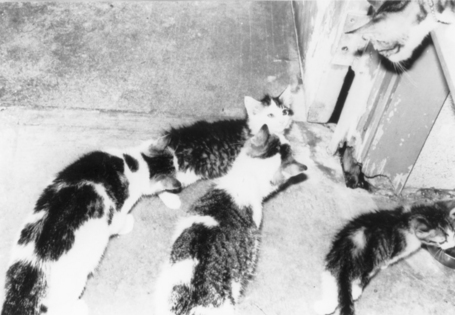
Figure 4-5 Adult cats showing a facial approach and an anogenital approach to a newly introduced kitten.
When confronted with its image in a mirror, a cat usually approaches with interest and often tries to locate the image behind the mirror. This indicates no self-identification.65 If a threat reaction is initiated, it usually intensifies because of the continually increasing threat display by the image.
Socialization
Although every age is important in the normal development of a kitten, four periods are unique and particularly critical in behavioral development.58,167 The infantile or neonatal period is characterized by neonatal ingestive and sleep patterns. The transitional or intermediate period begins during the second week with the appearance of adult patterns of eating and locomotion and of immature forms of social behavior. The socialization period is the time when all primary social bonds are formed and constitutes the single most important period during the cat’s life. During this phase, striking behavioral changes also occur because of growth and experience. The fourth period of kitten development, the adolescent or juvenile period, is primarily a time for maturation of motor skills.
Socialization is a process by which an individual forms an attachment to the other species it contacts during a limited time (see Appendix D). The socialization period is a developmentally sensitive time during which the individual is the most responsive to social stimuli.144 If the kitten is not exposed to appropriate stimuli, it may never develop appropriate responses. Early environments and social relationships are definitely important in socialization. The socialization process can occur between a kitten and humans or between a kitten and its “natural enemies,” such as dogs, rats, mice, or birds (Figure 4-6). These attachments result in the “unusual” yet perfectly normal pictures so often seen in newspapers (Figure 4-7). Only after a great deal of training might a grown cat accept or tolerate a species with which it was not acquainted during its socialization phase.
The long process of domestication generally produces animals with a naturally reduced tendency to flee from humans. By working with a young animal, domesticated or not, one can reduce the flight distance to zero and thus environmentally effect a psychologic change in an individual, which is called taming. Kittens handled after 2 weeks of age become more responsive to people than those not handled or those not handled until at least 7 weeks of age.97,98,119 Handling before 2 weeks makes no difference. Handling by multiple people makes kittens much less fearful of people compared with those with single-person handlers.32 The downside is that the kittens exposed to multiple people show less social and play behaviors.32,98 Without this environmental contact the kitten naturally tends to avoid humans, as often is the case with cats raised in a woodpile or hayloft. Even when carefully raised in association with humans, kittens have a normal period of human avoidance, which gradually appears between 40 and 50 days of age, is strongly obvious shortly thereafter, and if socialization to humans has occurred, ends sometime after the seventieth day.
The kitten that generalizes taming to all members of a species is said to be socialized to that species. Because eyesight is still developing in the kitten, visual recognition is probably somewhat limited, as in the dog. Forms of young children do not look the same as those of adults to a kitten, so exposing it to both types of humans might be important to ensure proper socialization. Rough play and handling during socialization result in the cat’s becoming either wild and aggressive or timid and nervous with people.26 Similar results occur if the kitten has little or no human contact during this early stage or if it is separated from its littermates and mother at 2 weeks of age.23,65,67,188
Species identification also occurs during the socialization period. Not only does this permit the cat to recognize other felines so that future matings are not a problem, but it also teaches the animal to tolerate if not fully accept other cats in social situations. Cats raised with members of other species in addition to their own will accept both but form stronger attachments with their own species. If raised only with other species during socialization, the cat forms attachments only to the adopted species.98,105 Future mate selection can then be a serious problem because the cat fails to identify with its own species.
The exact amount of time necessary for socialization of the cat is not known. In other species, socialization begins with the appearance of behavioral mechanisms that maintain or prevent social contacts, and perhaps for the kitten, socialization starts with the development of emotional reactions.172 The critical period ends with development of a fear response,97 which is probably associated with a particular stimulus causing the young to leave the vicinity.172 The socialization period must then include the ages of 5 to 7 weeks and probably ranges from 2 to 9 weeks of age. Careful handling of the kitten may extend this period for a few more weeks, and prolonged social exposure to certain individuals may even result in some form of attachment.54,59,172
The socialization process is faster if the kitten encounters stress; has a strong emotional experience such as hunger, pain, or loneliness172; or is handled intensively.98,144 This experience encourages rapid species identification. Once the socialization period passes, however, it becomes extremely difficult to acquaint the cat with other species except to occasional individuals. Hand-reared kittens are slower to develop normal responses.144
The young kitten is imprinted to its mother within the first few days of life, as evidenced by its reaction to separation, and olfaction plays an important role in the formation of the bond. Early approach behaviors also ensure early socialization to cats. The end of this species identification period is signaled by an increased tendency to avoid the unfamiliar,57 and the 3- to 6-week age seems the most important in intraspecies socialization.144 Secondary social relationships can then be developed by means of socialization. About 15% of cats will be resistant to socialization.107
Aggression
Agonistic behavior is a competitive interaction between two or more individuals that involves body postures and displays related to flight, defensive attack, and offensive attack. Aggression and the associated escape and passive postures are relatively common in the feline species. Neutering may not dramatically decrease the amount of aggression between cats, except in forms of aggression that are testosterone dependent. Neutering does, however, result in an increase in “friendly” interactions in both males and females.39,141
Much of the confusion in the literature regarding aggression has resulted because there are several different kinds of aggression displayed by the cat. This fact has often been neglected, so studies of cats attacking rats are equated with cats protecting themselves, showing fear, and being involved in other aggressive situations. It has made reviewing the literature very difficult. Classification of aggression can be done in several ways—by target, active or passive defense reflexes, learning, or function.20 Classification by function is practical in a clinical setting, resulting in approximately 15 different categories.11
In certain situations, aggressive behavior is considered perfectly normal; however, cat owners generally consider it to be a problem behavior. Because it is difficult to differentiate normal from problem aggression, most forms are discussed here. Aggression is a commonly reported behavior problem for cats, representing 17% of the problems in geriatric cats27 and up to 35% of the regular behavior cases.* Because the claws and teeth of a cat are such formidable weapons, aggression by the cat can become a significant problem. Although figures vary, somewhere between 6% and 20% of the reported bites that animals inflict on humans are caused by cats, and most of those bitten are children.63,83,95,187
Affective Aggression
Affective and nonaffective aggression are broad categories defined by the presence of an intensive, patterned autonomic activation, which especially involves sympathoadrenal interactions. Cats that hiss and show aggressive body postures are displaying affective aggression. Eight types of aggressive behavior can be classified as affective aggression, but several behavioral characteristics appear in all types.161 Although menacing vocalizations and threat postures may be only displays, they may progress to a full-rage attack with teeth and claws that is directed toward the provoking or threatening object, to escape flight, or to tonic immobility.47,56,188 These threats range from low intensity, in which the cat crouches and holds its ears slightly back; to middle intensity, in which the cat flattens its ears and hisses; to high intensity, in which these displays are combined with arched back, piloerection, inverted-U tail position, and lowered head. Submission is generally not considered a major part of a cat’s behavioral repertoire, because it retreats instead. Unlike the social species, a fleeing cat does not induce flight behavior in other cats. There is no “sympathetic induction of mood.”118
Because it is not related to sexual or food-gathering behaviors, various types of affective aggression are often not goal directed but are usually initiated by either a somatic or an external stimulus that lowers the irritability threshold for the aggression.161 Genetic factors are related to these behaviors. Some cats that are basically aggressive toward humans, other cats, or both have produced offspring showing these same behaviors regardless of how they were raised. Visual and olfactory stimuli can elicit adultlike agonistic behavior patterns as early as 6 weeks of age.102
A cat that stands firm during an attack of affective aggression from another cat, rather than running away or submitting, has about a 65% chance of inhibiting or avoiding the attack.138
Intermale aggression
Fighting between tomcats is a common form of feline aggression. The presence of testosterone in the prenatal and neonatal kitten masculinizes the young brain. Later production of testosterone potentiates the earlier presence of the hormone and produces male behaviors, including fighting. Castration usually eliminates this later facilitation of male aggression, so castrated cats do not commonly fight.76 Testosterone plays a significant role in intermale aggressive behavior in the cat, because it is selectively taken up by the portions of the brain that control aggressive behavior. In addition, it is responsible for the loose attachment and dermal thickness of the neck skin. Intermale aggression increases during periods of overcrowding and the mating season, but an estrous female need not be present. The increased frequency during mating season results from a greater number of encounters with young wandering males, called floaters, as they emigrate from their birthplace rather than from cyclic hormone changes.45,140 Differential diagnoses for intermale aggression include competitive, territorial, and sexual aggression.
Area males establish a “brotherhood” or “fraternity” by aggressive interactions. When a young male reaches puberty, one or two of the local tomcats begin to call in a soft vocalization similar to that of a tomcat calling an estrous female. When the young male approaches, severe fighting ensues.41,112,114 These encounters continue for about a year, and if the younger cat is still alive and has not become totally fearful, he is accepted into the group.59,112 Unlike other social groupings, the brotherhood has an absolute ranking order that holds regardless of whenever or wherever members meet.112 The cats are of almost equal strength, so even a threat display rivalry can change the narrowly separated ranking positions.59,112,113
Any initial meeting between two males arriving in a new territory simultaneously results in a similar behavior. An intense fight allowed to go to completion is followed by a situation in which threat displays adequately prevent further interactions.6,112
Because intermale aggression is related to testosterone, castration has been successful in minimizing 80% to 90% of the behavior in cats so treated.76,77 In addition, various long-acting progestogens have been successfully used to control this aggression, including medroxyprogesterone acetate and megestrol acetate. Several other drugs with similar actions can also be used. Specifics of male behaviors are discussed in Chapter 5.
Pain-induced aggression
Pain effectively elicits defensive aggression, and it can cause aggression at levels significantly greater than expected in certain situations.90 Obvious causes of pain-induced aggression include attacks on humans when a cat’s hair or tail is pulled or when its tail is stepped on. Continued application of pain eventually causes the cat to submit to the stimulus or try to escape it.56 Early social play helps teach the kitten what pain is and how much pain it can inflict on others. If slight oral pressure elicits a pain reaction from a littermate, the kitten learns this by the victim’s reaction. Singly raised orphans are deprived of this learning experience. Those who do not have the opportunity to play with littermates may also miss this important lesson.
Stay updated, free articles. Join our Telegram channel

Full access? Get Clinical Tree


